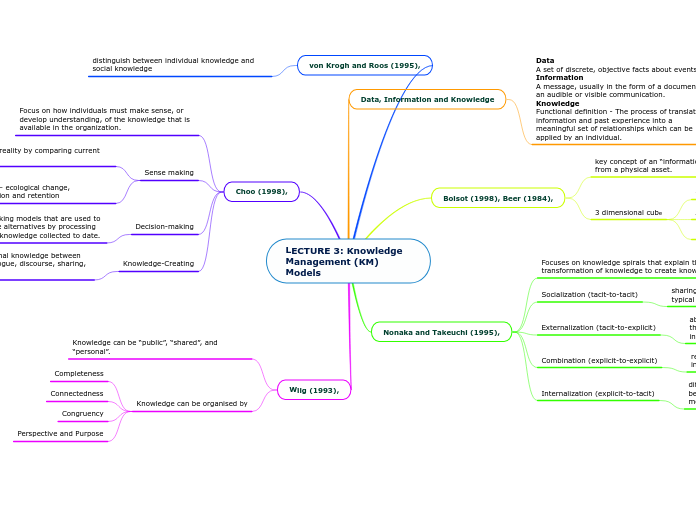LECTURE 3: Knowledge Management (KM) Models
Data, Information and Knowledge
Data
A set of discrete, objective facts about events.
Information
A message, usually in the form of a document or an audible or visible communication.
Knowledge
Functional definition - The process of translating information and past experience into a meaningful set of relationships which can be applied by an individual.
Boisot (1998), Beer (1984),
key concept of an “information good” that differs from a physical asset.
3 dimensional cube
Codified-Uncodified
Abstract-Concrete
Diffused-Undiffused
Nonaka and Takeuchi (1995),
Focuses on knowledge spirals that explain the transformation of knowledge to create knowledge
Socialization (tacit-to-tacit)
sharing knowledge in face-to-face, natural, and typical social interactions
Externalization (tacit-to-explicit)
able to articulate the knowledge and know-how, the know-why and etc., i.e. a journalist interviewing an expert
Combination (explicit-to-explicit)
recombining discrete pieces of explicit knowledge into a new form
Internalization (explicit-to-tacit)
diffusing and embedding newly acquired behaviour and newly understood or revised mental models
von Krogh and Roos (1995),
distinguish between individual knowledge and social knowledge
Choo (1998),
Focus on how individuals must make sense, or develop understanding, of the knowledge that is available in the organization.
Sense making
representation of reality by comparing current with past events
Sense making
Involve 3 phases – ecological change, enactment, selection and retention
Decision-making
rational decision-making models that are used to identify and evaluate alternatives by processing the information and knowledge collected to date.
Knowledge-Creating
transformation of personal knowledge between individuals through dialogue, discourse, sharing, and storytelling.
Wiig (1993),
Knowledge can be “public”, “shared”, and “personal”.
Knowledge can be organised by
Completeness
Connectedness
Congruency
Perspective and Purpose
